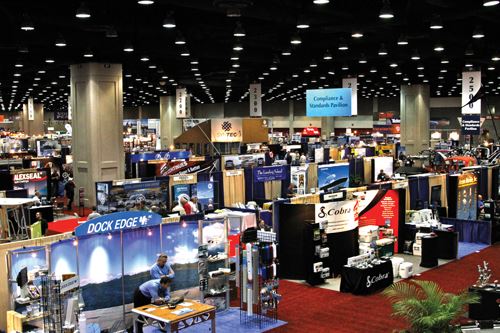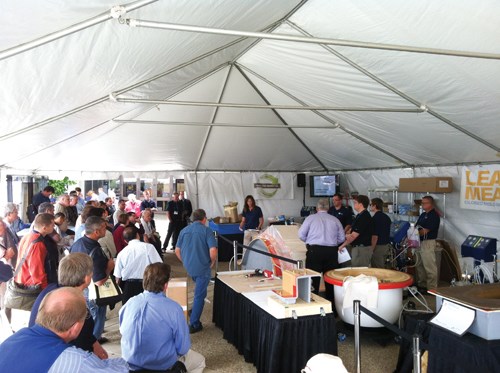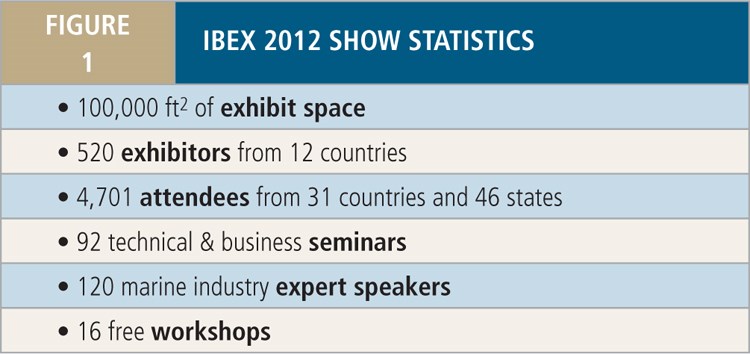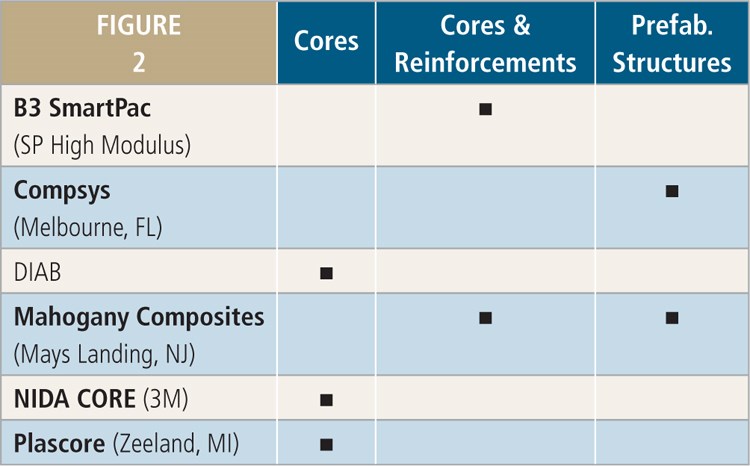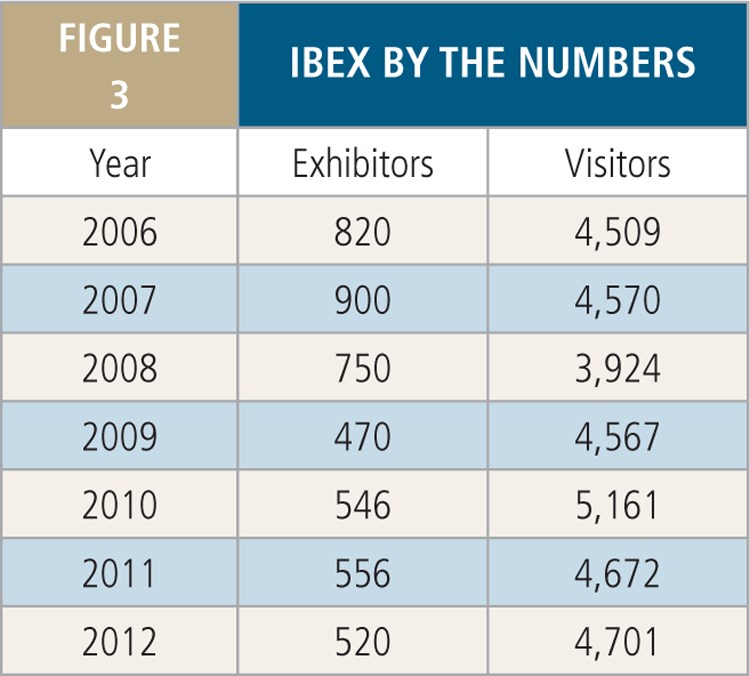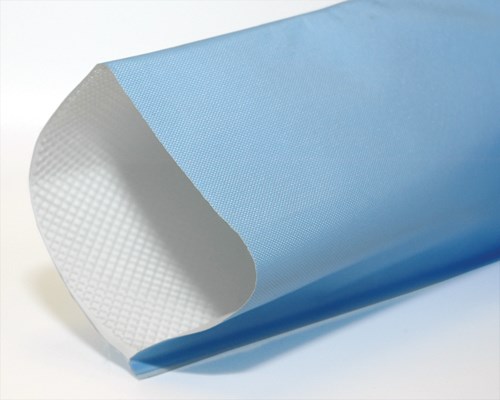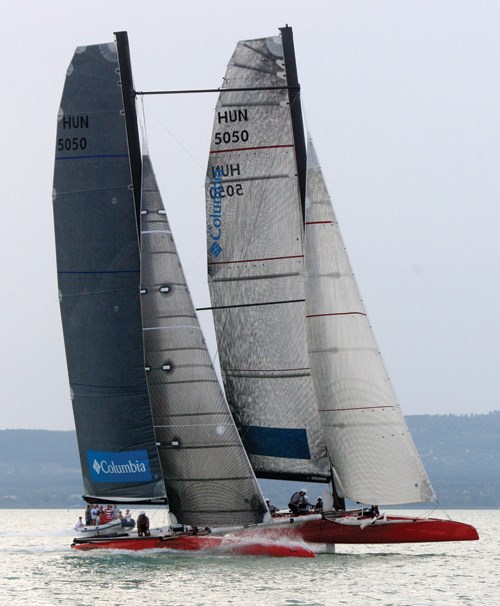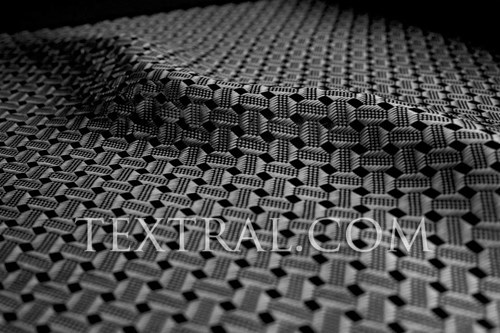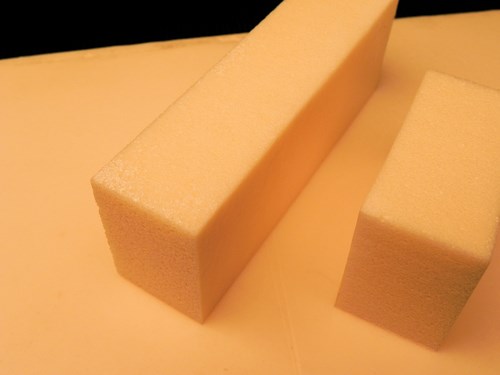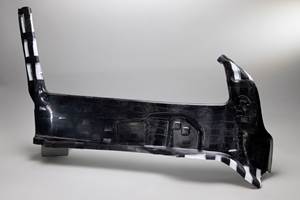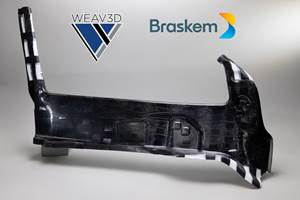IBEX 2012 Review
Under the banner “The Future of Marine Technology,” the 22nd International BoatBuilders’ expo confronts a brave new world.
The marine industry’s largest technical trade event was held, again this year, far inland along the Ohio River, at the Kentucky Exposition Center (Louisville, Ky.). The International BoatBuilders’ Exhibition (IBEX) was cohosted Oct. 2-4 by Brooklin, Maine-based Professional BoatBuilder magazine and the National Marine Manufacturers Assn. (NMMA, Washington, D.C.).
IBEX opened this year with a keynote address by Steve M. Murdock, former director of the U.S. Census Bureau. He set the tone for the exhibition’s examination of the marine market’s future by discussing how demographic trends in the U.S. population could affect boating. He suggested the boat market could double in size if the industry could increase boat buying among Hispanics to the same level it has achieved among non-Hispanics. The NMMA added a special market intelligence session that featured economists and market specialists in fishing, outdoor sports and boating. NMMA president Tom Dammrich noted that boat sales are continuing to rise in most marine segments. This was confirmed by Matt Chambers, president of Marine Concepts/Design Concepts (Cape Coral, Fla.), who cited an increase in new model development across boat types and sizes, from kayaks and ski boats to high-performance craft and models from 40 to 50 ft in length. To keep up, Chambers says, his company is expanding into a new location and has purchased its sixth CNC machine, supplied by PaR Systems (Shoreview, Minn.), to meet demand for faster cutting, tighter tolerances and the ability to cut carbon fiber and other hard-to-cut materials.
Many exhibitors noted that IBEX attendance (up just 1 percent over 2011) reflected the continued sluggishness in the marine market, and though they continue to see positive signs, they believe the peaks that once followed industry slowdowns are a thing of the past. Comments were made that this was the best IBEX in three years (see Fig. 1 & 3 for comparisons), and there was surprise, as well, at the lack of talk about the new styrene labeling rule now in effect and its possible implications for the industry.
IBEX composites seminars continued to look forward, urging the industry to continue its improvement in materials, design and processing, with special emphasis on vacuum infusion processing and curing (e.g., “Vacuum Bag Basics,” “Cure Cycles and Post Curing,” and “Vacuum Infusion for Carbon Fiber Laminates”). In addition to the technical focus, presenters looked at marketing opportunities overseas (“Global Production BoatBuilding”) and how manufacturers can improve efficiency and costs, in sessions titled “Plant Layout,” “Cost and Efficiency of Resin Infusion,” and “Lightweight Composite Technology for Improving Efficiency.” And one seminar focused exclusively on composites regulatory issues.
Notably, Composites Consulting Group (DeSoto, Texas) presented test results that compared single-bag vs. double-bag vacuum infusion in an attempt to determine what, if any, value the latter may have for marine applications. The Group noted that single-bag infusion with tight process control and double-bag infusion were shown to deliver roughly the same result; but presenters agreed that the sample — 10 test pieces —was too small to be statistically conclusive. Additional testing is under consideration.
On the show floor
Increasing efficiency through better use of materials and labor was also the trend among Composites Pavilion exhibitors. Kitting was a common theme (see Fig. 2, at left), spreading beyond reinforcements and cores to prefabricated stringers and bulkheads, as well as precut and preseamed vacuum bag materials. Other efficiency innovations on exhibit included tools with vacuum capability to remove debris and reduce consumables (see Dynabrade item, below) and adhesives designed to replace the labor of mechanical fasteners (see ITW Plexus item, below).
Among the first-time exhibitors in the Pavilion were two long-time marine industry composites suppliers — French Canadian resin source Tri-Tex and Japan-based ACMOS Inc., represented by its U.S. sales office in Maryland — and a surfacing veil supplier, Creatis LLC, from Indiana.
The CT staff found these and other exhibits of interest to marine composites manufacturers on the show floor, of which the following is a notable sampling.
Semipermanent mold releases
With a 26-year history in the U.S., ACMOS Inc. (Lutherville, Md.), a supplier of mold release systems compatible with urethane, polyester, vinyl ester and epoxy resins, exhibited its semipermanent release systems for the first time at IBEX. In the spotlight was its new ACMOScoat 82-9100, which reportedly saves 30 percent in application time by enabling more demolded parts per application. With its headquarters in Nomura, Japan, the company has facilities located in Bremen, Germany, in addition to offices in Lutherville and nearby Hanover, Md.
Breather strips for vacuum infusion
Airtech International Inc. (Huntington Beach, Calif.) introduced its MC-79 vacuum breather strip. According to the company, it simplifies vacuum bagging and helps control flow in resin infusion. Made from Dahltexx SP-2 fabric, this strip material helps to ensure wet out and avoids dry patches by providing even vacuum distribution over the part for efficient air removal. It can be applied over the surface of a laminate with no resin bleed out and little mark-off; or it can be used with a localized vacuum source to draw resin into dry areas or to avoid dry patches via stringer top vacuum manifolds.
Molding compound core substitute
ATC Formulated Polymers Inc. (Burlington, Ontario, Canada) announced type approval for its Core-Bond family of products by the marine vessel classification society the American Bureau of Shipping (ABS, Houston, Texas). ATC’s CEO, Jean-Pascal Schroeder, also discussed how a variety of boatbuilders are experimenting with POLY-BOND B55LV Molding Compound to reduce material and labor cost in the production of various parts. Campion Boats (Kelowna, British Columbia, Canada), for example, is replacing core with B55LV in hatches that are gel coated on both sides using a low-pressure displacement molding process (also known as squish molding) to eliminate consumables and reduce tooling costs for simple parts. Campion claims additional savings by eliminating skin layer reinforcements without print-through issues. Schroeder says other builders are using B55LV in hard tops and door tops and are experimenting with it as a substitute for syntactic core, saying it offers a lightweight, tappable material with reportedly twice the screw retention of plywood.
Hands-on training courses
CCP Composites (Kansas City, Mo.) publicized its CCP University, an annual schedule of more than eight hands-on training courses offered across the country, with topics including Tooling Construction, Gelcoat Application and Patching and Closed Molding/LRTM/CCBM/VIP. The company also provides the industry-renowned Cookbook applications guide, which is now available digitally on CD-ROM and via its Web site at www.ccpcompositesus.com.
Uniquely patterned carbon fiber wovens
Composite Fabrics of America (CFA, Taylorsville, N.C.) exhibited its TEXTRAL 3K and 12K carbon fiber fabrics in standard widths to 80 inches/203 cm (greater widths, custom), with “unique” weaves that create visual impact. Although CFA is only three years old, it says it benefits from the more than 90 years of textile experience acquired by parent Schneider Mills (New York, N.Y., and Taylorsville). “Leveraging our parent company’s extensive weaving expertise, we have developed technologies enabling us to weave carbon, aramid and other advanced fibers into fabric patterns that are both structurally sound and aesthetically striking,” said regional sales director Jack Loudermilk. CFA supplies all of the traditional composite fabrics, plus more than 30 different exotic TEXTRAL weaves, and can create customer-exclusive designs like logos.
Sprayable, reusable rubber vacuum bag materials
Distributor Composites One (Arlington Heights, Ill.) continued its annual Closed Mold Alliance demonstrations and promoted the newest addition to its wide array of closed molding materials and equipment options: SPRAYOMER nonsilicone reusable vacuum bag materials. Manufacturer SR Composites (Henderson, Nev.) lent testimony to SPRAYOMER’s advantages, which come from using modified natural rubbers with extreme tear-resistance and flexibility, enabling the formation of reusable bags that are reportedly thinner and lighter than silicone bags, with a typical payback vs. disposable bags at 25 to 30 cycles for parts of practically any size or shape. The base material is biodegradable and renewable, with a carbon footprint estimated at 50 percent that of synthetic rubber.
Composite structural and infusion flow analyses
Composites Consulting Group (CCG, the consulting arm of DIAB, DeSoto, Texas) highlighted its work in flow modeling analysis, done in conjunction with Vectorworks Marine (Titusville, Fla.) on the latter’s 145-ft River Hawk patrol boat, which features what is believed to be the largest infused hull to date (see photo), and the M10 hovercraft. The M10 relies on 10-ft/3m diameter, all-carbon-fiber propeller ducts that weigh in at only 210 lb/95.3 kg each, a feat enabled by CCG’s analytical consulting expertise (see also Engineered Bonding Solutions item, below).
Decorated surfacing veils
Creatis LLC (Millersburg, Ind.) offered its Phantom Veil polyester and glass fiber surfacing veils, available printed with one of more than 30 “standard” and “nonstandard” designs (e.g., camouflage, brick, marble, sandstone and a variety of wood grains) or with a custom design, such as a logo. The company offers 1m2/10.8-ft2 samples, short lead times and has a one-roll (100m2/1,076-ft2) minimum order for standard designs.
Dust/debris-capture tools
Dynabrade Inc. (Clarence, N.Y.) promoted its extensive line of vacuum-operated dust- and debris-capture tools, including drills and diamond-wheel cutoff tools, offering reduced consumables costs for composites machining. For example, its orbital sander with vacuum capability reportedly extends the life of the sanding disk by sucking debris into the vacuum to prevent disk clogging. A longer disk life also reduces the number of consumable change-outs and boosts overall machining efficiency.
Hybrid urethane/silicone adhesives
Plexus (Danvers, Mass.) has developed the H-Series product line of one-component, semistructural urethane/silicone (hybrid) sealant adhesives that offer UV-resistance plus excellent elongation and flexibility. Described as a green product line, it is isocyanate-free, with low to no volatile organic compounds (VOCs). The adhesives are targeted to replace welds and metal fasteners in secondary structures, aesthetic applications and any applications with exposed bondlines.
Structural adhesives
Engineered Bonding Solutions LLC (Titusville, Fla.) celebrated the one-year anniversary of its Acralock adhesives in August. “We are rapidly expanding to meet the interests beyond North America into Asia, Europe and South America,” said company president Matt Brandli, who spotlighted recent marine applications: Sportsman Boats (Summerville, S.C.) uses SA10-100 to bond stringers to the hull and UV-resistant SA10-40WHT for small parts. Vectorworks Marine (Titusville, Fla.) used Acralock structural methacrylates in two foreign military projects, the 145-ft River Hawk patrol boat and two land-and-sea capable 70-ft M10 hovercraft (see photo) for EPS Corp. (Tinton Falls, N.J.). (See also the previous Composites Consulting Group item).
Combined E-glass/E-CR glass rovings
Owens Corning Composite Solutions Business (Toledo, Ohio) announced that its OptiSpray roving products are available globally. Designed for spray-up processing in marine, transportation and other applications, OptiSpray products are made with Owens Corning’s patented Advantex glass fiber, which combines the mechanical properties of E-glass with the corrosion-resistance of E-CR glass. OptiSpray’s benefits are said to include easy chopping, rolling and air release; flat lay down and uniform dispersion; and excellent conformability without spring back, including in challenging vertical parts.
Expand-in-place epoxy foam
Pro-Set Inc. (Bay City, Mich.) exhibited its M1034/M2037 expand-in-place epoxy foam. When it is mixed, this product creates, in-situ, a closed-cell epoxy foam with very uniform cell sizes. The expanding epoxy foam can be used as a core for lightweight composite structures. After cure, it will bond with fiber-reinforced plastic (FRP), metals and low-density core materials. To date the expanding foam product has been used in boat rudders, dagger boards and keel fins, but it also could see applications, says the company, in marine tidal turbine blades and stabilizer fins.
UV-resistant methacrylate adhesives
SCIGRIP Smarter Adhesive Solutions (Durham, N.C.) showcased its SG100-series of UV-resistant, two-part methacrylate adhesives. “The newly reformulated SG100-series delivers superior adhesion properties, while requiring minimal surface preparation for bonding a wide range of materials used in boatbuilding and marine applications,” said regional sales manager Kirk Miller. These nonyellowing adhesives are intended for bonding composites, metals or thermoplastics, and the reduced surface prep is said to cut labor costs and production cycle times.
Recycled polyethylene terephthalate foam
3A Composites , div. of Schweitzer Technologies Group (Sins, Switzerland) exhibited AIREX T92.80 SealX, a sealed version of its AIREX T92 polyethylene terephthalate (PET) thermoplastic foam. Said to exhibit the lowest resin uptake during infusion, compared not only to other PET cores, but to PVC foam as well, the foam is available in densities from 5 to 12.5 lb/ft3 (80 to 200 kg/m3). 3A claims this closed-cell foam core with recycled PET content is easy to process with no outgassing. It withstands process temperatures up to 302°F/150°C and it can offer cost savings, for example, by replacing PVC foam core with an equal-property SealX to reduce resin uptake. The result is said to decrease resin usage and therefore nets a cost-per-part savings, plus savings in core cost, with minimal impact on component weight (see photo and caption, at left).
Epoxy resin systems
Tri-Tex (Saint-Eustache, Quebec, Canada) exhibited its East System (the name has a 25-year history and is not related to West System) epoxy laminating and infusion resins, casting resins and fairing compounds. The epoxies include 24 individual systems for either room-temperature or elevated-temperature cure, including filled and unfilled systems and several systems with short-fiber reinforcements.
Reinforcement/flow media combo
Vectorply Corporation (Phenix City, Ala.) showed off its VectorCore reinforcements, which combine structural continuous glass fibers and a highly permeable polypropylene-fiber flow media. Intended for closed molding applications, the combination of glass reinforcement and flow media reportedly provides much higher mechanical properties compared to all-chop fiber or continuous filament mats (CFMs). Further, the VectorCore materials are said to have superior conformability and contribute to better surface cosmetics in the finished composite part.
Related Content
Composite resins price change report
CW’s running summary of resin price change announcements from major material suppliers that serve the composites manufacturing industry.
Read MoreHighly tunable, woven lattice reinforcements target automotive structures
CAMX 2023: Startup Weav3D will be demonstrating its two collaborative automotive demonstrator parts and present two conference papers.
Read More3D-woven composites find success in aerospace, space
CAMX 2024: Bally Ribbon Mills experts are displaying the company’s various joints, thermal protection system (TPS) technologies and other 3D woven composites for mission-critical applications.
Read MoreBraskem demonstrates PP solutions using Weav3D composite lattice technology
Partnership combines Braskem’s polypropylene sheets with Weav3D Rebar for Plastics technology to address new structural, automotive applications requiring high-strength, lightweight material solutions.
Read MoreRead Next
VIDEO: High-volume processing for fiberglass components
Cannon Ergos, a company specializing in high-ton presses and equipment for composites fabrication and plastics processing, displayed automotive and industrial components at CAMX 2024.
Read MoreAll-recycled, needle-punched nonwoven CFRP slashes carbon footprint of Formula 2 seat
Dallara and Tenowo collaborate to produce a race-ready Formula 2 seat using recycled carbon fiber, reducing CO2 emissions by 97.5% compared to virgin materials.
Read More“Structured air” TPS safeguards composite structures
Powered by an 85% air/15% pure polyimide aerogel, Blueshift’s novel material system protects structures during transient thermal events from -200°C to beyond 2400°C for rockets, battery boxes and more.
Read More

